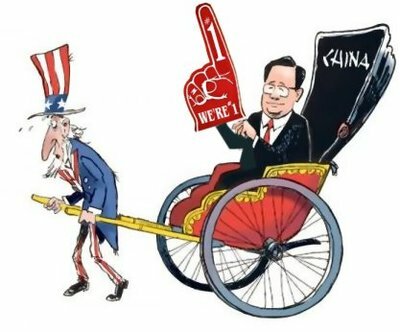MIT Explains: How did China come to dominate the world of electric cars?
 |
 |
China is called the future Silicon Valley of the electric vehicle world
Milton Snide's Brooklyn Street Kid China EV Take: Because most elected politicians are just too ignorant about alt fuels or are in Big Oil's pocket to make make an independent alt fuel decision, they delegate "their alt fuel position" decision to just as ignorant "expert" aides to determine which 'alt' to support, and because it's in vogue and they think safe, they support Electric vehicles. So these know nothings hurt America and help China...just look at the support and money being spent on Electric vs Ethanol a real gasoline alternative.
Think we are paranoid? Well wake the f--k up! It's in Silicon Valley's and China's best interest to emasculate automobiles and create a ground swell for a "Transportation Appliances" industry that replaces traditional automobile design and manufacturing. In a new electric and autonomous transportation world they can both dominate, just how many Chinese citizens(2018) with advanced degrees earned at American universities are employed at digital transportation companies in Silicon Valley? Just Sayin'.
More Snide's China EV Insights:
- Chinese Government Has Long Term View Of Major Initiatives
- Chinese Acquiring All Elements To Take Over World's Auto Industry; Lithium, Batteries, Raw Material, EV Factories (So what if it takes 50 years?)
- California EV-only Mandates To Ooze to other Blue States
- By 2035 Chinese Car Makers will have 15 plus years learning to perfect their mass production and profitable shortcuts of Electric car making, selling and battery disposal processes.
- Traditional car makers will be scrambling to obtain batteries and learn how to dispose of depleted batteries
- China can take depleted batteries back to China for rebuild or disposal
- Chinese EV will cost 50% of US and European built cars
- Hyundai and Kia will become the entry luxury EV brands, GM will be out of business, Ford will be selling just trucks, Exotics like BMW will be black-marketed to California
- China will supply controllable (On Off Via Net) EV charging stations throughout California, Oregon, Washington State, New Jersey, DC, Hawaii, Massachusetts, Vermont, and New Hampshire.
- Ignorant Traitorous Politicians, Traitorous Bureaucrats, Wall Street Sharks, and Traitorous Green New Dealers Are Found integral in Chinese takeover of USA - face firing squad.
SEE ALSO: Benefits Of California's Partnership With China (Nov 2013}
SEE ALSO: Electric vehicles Solution or Diversion? (2009)
SEE ALSO: China Given A Path To Worldwide EV Domination - Updated (2018)
SEE ALSO: China's World Automotive Domination Library(1995-2023)
MIT Tech Review Explains
By Zeyi Yang(2023)
From generous government subsidies to support for lithium batteries, here are the keys to understanding how China managed to build a world-leading industry in electric vehicles.
Before most people could realize the extent of what was happening, China became a world leader in making and buying EVs. And the momentum hasn’t slowed: In just the past two years, the number of EVs sold annually in the country grew from 1.3 million to a whopping 6.8 million, making 2022 the eighth consecutive year in which China was the world’s largest market for EVs. For comparison, the US only sold about 800,000 EVs in 2022.
The industry is growing at a speed that has surprised even the most experienced observers: “The forecasts are always too low,” says Tu Le, managing director of Sino Auto Insights, a business consulting firm that specializes in transportation. This dominance in the EV sector has not only given China’s auto industry sustained growth during the pandemic but boosted China in its quest to become one of the world’s leaders in climate policy.
How exactly did China manage to pull this off? Several experts tell MIT Technology Review that the government has long played an important role—propping up both the supply of EVs and the demand for them. As a result of generous government subsidies, tax breaks, procurement contracts, and other policy incentives, a slew of homegrown EV brands have emerged and continued to optimize new technologies so they can meet the real-life needs of Chinese consumers. This in turn has cultivated a large group of young car buyers.
But the story of how the sector got here is about more than just Chinese state policy; it also includes Tesla, Chinese battery tech researchers, and consumers across the rest of Asia.
When did China start investing in EVs and why?
In the early 2000s, before it fully ventured into the field of EVs, China’s car industry was in an awkward position. It was a powerhouse in manufacturing traditional internal-combustion cars, but there were no domestic brands that could one day rival the foreign makers dominating this market.
“They realized … that they would never overtake the US, German, and Japanese legacy automakers on internal-combustion engine innovation,” says Tu. And research on hybrid vehicles, whose batteries in the early years served a secondary role relative to the gas engine, was already being led by countries like Japan, meaning China also couldn’t really compete there either.
This pushed the Chinese government to break away from the established technology and invest in completely new territory: cars powered entirely by batteries.
The risks were extremely high; at this point, EVs were only niche experiments made by brands like General Motors or Toyota, which usually discontinued them after just a few years. But the potential reward was a big one: an edge for China in what could be a significant slice of the auto industry.
SEE COMPLETE ARTICLE: HERE


